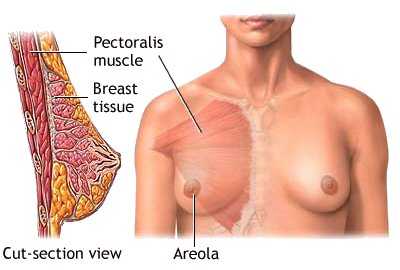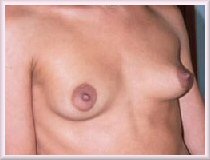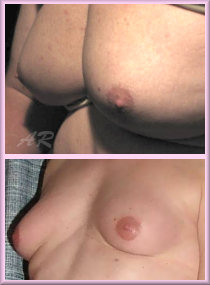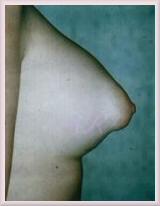
Breast Development
(In Male-to-Female transsexuals)

| For all women, breasts are a very important and very visible aspect of their "womanhood". It is also probably fair to say that the female breast is regarded by men and women as a key aspect of |
feminine beauty
- both in our modern society and historically.
|
The development of breasts gives the male-to-female transsexual woman a tremendous confidence boost, and powerfully identifies her as a female to others. It is also impossible to ignore that the fact that breasts are immensely strong sexual symbols, and secondary sexual organs whose presence can be enjoyed by both the owner and their partner. Unlike a vagina, breasts can be easily and acceptably be publicly displayed in either part (cleavage) or full (e.g. topless sun bathing), or prominently implied underneath a skimpy top. Bra's and [usually] breast forms/padding are essential early purchases for every transsexual woman.
|

While ultimately many transsexual women will have
breast implants
, the first step is always
female hormone treatment
, using oestrogen and anti-androgens to enable the growth of breasts to their maximum natural
size
- although this is somewhat less than that of close female relatives. Breast growth can often be enhanced by use of appropriate progesterone, causing a more natural breast shape to form with lactating and ducting tissue as well as the fatty tissue laid down by estrogen treatment. If the woman starts treatment already past puberty, the resulting breast development can range from respectable to very disappointing - although even in the latter case it should be noted that modern bra's, "push-ups" and breast enhancers can still do wonders appearance wise. But the final breast development may still be regarded as unsatisfactory, particularly in older patients, in which case implants may be desired.
|
The Breast
|
A breast (also known as a mammary gland) is a quite complex structure consisting of a mass of fatty tissue and nerves served by a good blood supply. Fully developed, each breast when lactating is capable of supplying a pint or more a day of nourishment (milk) and immunoglobulins to a nursing infant. Visible in the centre of the breast is the protruding nipple, which is surrounded by a pigmented circular area called the areola. Small glands in and around the nipple provide lubrication and protection against infection, which is particularly important for breast-feeding mothers. Produced by the lobules (consisting of alveoli) in the interior of the breast, milk is carried to the nipple by a collection of tubes known as ducts.
|

Above, the male breast, and below the female breast
|
|



An interesting picture as one of the women is genetically XX and the other XY.
|
Breast Development in the Genetic Woman
|
At birth the rudiments of the functional mammary gland are in place for both boys and girls: the nipple and areola are formed along with a rudimentary system of mammary ducts extending into a small fat pad on the chest wall. The mammary gland remains a rudimentary system of small ducts until puberty when in a genetic woman the advent of estrogen secretion by the ovaries brings about the first stage of the four stages of mammary development: mammogenesis. Only the breasts of child bearing women go through the next two stages - lactogenesis and lactation. Finally, the breasts of all post-menopausal women go through involution, although hormone replacement therapy can affect this.
|
Mammogenesis commences at puberty with the onset of estrogen secretion by the ovaries, usually between the ages of 10 and 12 in a genetic girl. Estrogen (often spelt 'Estrogen' in American English) stimulates breast growth by acting causing enlargement of the mammary fat pad, one of the most estrogen-sensitive tissues in the human body, as well as lengthening and branching of the mammary ducts. The development occurs according to well-defined milestones called Tanner stages:
|
Tanner Stage
|
|
Average Age
|
Description
|
|
I
|
|
10 - 12 years
|
Increased nipple size
|
|
II
|
|
+ 6 months
|
Increased areola as well. Breast bud (small tender lump behind the nipple)
|
|
III
|
|
+ 18 months
|
Nipple – areola complex increases. Breast size increases
|
|
IV
|
|
+ 24 months
|
The areola is a separate mound above the breast
|
|
V
|
|
+ 42 months
|
The areola becomes confluent with the breast
leaving only the nipple proud
|
|
|

|
Breast development, Tanner Stages I to V
|
The levels of estrogen required to cause breast development are surprisingly low - until stage IV, the growth of the breast in a girl takes place with estrogen levels similar to an adult male. That is why about 40% of male children also initiate "Tanner I" type mammary development during their puberty due to the tendency of their testis to secrete significant quantities of estrogen's in early phases of its development. However, as testosterone secretion increases the breast development ceases and very few boys reach the Tanner II stage.
|
|

It takes approximately two to three years for a girl to achieve the majority of her breast growth. Stage V is aligned with the onset of the menstrual cycle - which results in the production of progesterone for the first time. The presence of progesterone stimulates the partial development of mammary alveoli, so that by the age of 20 the mammary gland in the woman who has not been pregnant consists of a fat pad through which pass 10 to 15 long branching ducts, terminating in grape-like bunches of mammary alveoli. In the absence of pregnancy the gland maintains this structure until menopause. It's worth noting that these ducts are very small and contribute little to breast size.
Additional chapters in This Section include:
Gender Reassignment Surgery
Orchiectomy for MTF Transsexual Women
Bilaterial Orchiectomy Atlanta
FFS Facial Feminization Surgery
MTF Transsexual Surgeries
Hormone Replacement Therapy for Transgender Women
Female Hormone Therapy MTF Transsexuals
Breast Development in MTF Transsexuals
MTF Transsexual Breast Enlargement
Breast Augmentation MTF Transsexuals
Lactation and the Transsexual Woman
Injecting Silicone for Transsexual Women
Brazilian Hips and Buttock Enlargement
Average Body Size MTF Transgender
Male and Female Skeleton Transsexuals
Treatment of Young Transsexuals
Puberty in Adolescents MTF Transgender
Treatment of Young MTF Transsexuals
Treatment of Intersex Infants
Androgen Insensitivity Syndrome
Female Physical Beauty Transgender
Transgender Female Beauty
Exercise, Fitness and Diet for Transsexual Women
In Europe and the USA more than half of adult genetic women are a B to C bra cup, and relatively few (<25%) women are naturally a D cup or greater. But the figures vary widely from study to study, e.g. Triumph's European Bra Size Survey from 2007 famously found that 57% of UK women were D cup or more - a highly improbable finding which was widely reported in the UK media.
|

Mammogenesis is completed during pregnancy, with the gland becoming able to secrete milk sometime after mid-pregnancy. Pregnancy is often considered to be the period of most extensive mammary growth. Indeed extensive lobular and alveolar development occurs only during pregnancy. During pregnancy, it is not unusual for a woman's breast size to temporarily increase by a full cup size.
Lactogenesis (referred to as the time when the milk "comes in") starts about 40 hours after birth of a baby and is largely complete within five days. When nursing ceased the breast undergoes partial involution, losing most of its milk producing cells and structures. Many women have slightly smaller breasts after pregnancy and nursing because they have less fatty tissue and once the breast is no longer swollen with milk it can sag in an unsightly manner.
Innovolution completes after menopause, when many women move to a smaller bra size.

Sarah, a 24 year-old transgirl - shown after 10, 17 and 26 months on hormones.
|

A good example of the type of breast development that transsexual women starting female hormones post-puberty may achieve.
|
Breast Development in the Transsexual Woman
Every person whether genetically male or female is born with milk ducts — a network of canals that transport milk through the breasts — present from birth. In the male-to-female transsexual woman the mammary glands stay quiet until commencing female hormone treatment releases a flood of estrogen's, causing them to grow and swell in what is effectively a female puberty and initiating the first phase of mammogenesis.

Transsexual women must examine their breasts regularly for signs of problems
Although often only partially developed, the breast structure of a transsexual "XY" woman is basically the same as a genetically "XX" woman after the first phase of mammogenesis, indeed transsexuals with well-developed breasts are quite able to
nurse
given the right stimuli.
It's important to note that all the common information and rules about the female breast (including the need for regular breast self-examination and mammogram's) apply just as much to transsexual women taking estrogen as they do to genetic women.
Externally, breast growth and development is medically defined by "Tanner's Five Stages":
Tanner Stage
|
|
Description
(as applies to transsexual woman)
|
Example
|
Stage I
|
|
(Pre-hormone treatment)
|
The undeveloped "pre-adolescent" pre-hormone type breast consists of a small elevated nipple (papilla) only, with no significant underlying breast tissue.
|

Stage II
|
(Hormone treatment started)
|
After 6-8 weeks of hormone treatment subareolar nodules can be (painfully) felt and the nipple becomes very sensitive. After about three months breast buds will visibly start to form.
|
There is an elevation of the nipple and surrounding breast area as a small but increasingly obvious mound, and the areola diameter may begin to enlarge (particularly in young women). Milk ducts inside the breast begin to grow. Elderly transwomen may not get beyond this stage. There is a lack of material for satisfactory breast implants - any implant will be very obvious.
|
Stage III
|
This stage is reached by most transwomen after between six months and a year of continuous hormone treatment.
|
There is further enlargement and elevation of the breast and areola (with no separation of their contours). The areola may begin to darken in colour. The milk ducts give rise to milk glands that also begin to grow.
|
Stage IV
|
If achieved, it will take one to two years to reach this stage.
|
There is a projection of the areola and papilla to form a secondary "mound on a mound" above level of breast. Many twenty-something transsexual women display this characteristic after pro-longed hormone use. Suitable breast implants can result in an excellent Tanner V-like appearance.
|
Stage V
|
Only a very few transsexual women (mostly under age 20) reach this "mature" stage, after two or three years of hormone treatment.
|
The breast has now fully filled out and only the nipple still projects, the areola has recessed and become part of the general breast contour i.e. the secondary mound has disappeared.
|

|
|
Cheryl (shown
age 35) has occasionally taken hormones since her early 20's. She hasn't transitioned and her breast development is a problem for someone living life as a man.
|
After female hormones are commenced the breast slowly evolves and gradually increases in
size
, often with periods of growth and periods of apparent standstill. In the initial phase of hormone therapy subareolar nodules - which can be painful - are common. Both estrogen and progesterone should be taken, it's thought that estrogen stimulates cell mitosis and growth of the ductal system, while growth, development and differentiation of the glandular tissue (called lobules or alveoli) seems to be dependent on progesterone, and breast fat accretion seems to require both.

Loira, mid-20's - after two years hormones. The breast size is similar to many girls in their early teens, but unfortunately on a larger rib cage.

A transwoman in her 30's. The hormone regime is not known, but but the development is consistent with 4 or 5 months of full dose hormones.
It's perhaps worth emphasizing here that the results of female hormone treatment eventually become obvious to everyone, whether called breasts or "man boobs". Indeed breast growth is often a severe embarrassment for the pre-transition woman on hormones - ranging from in bed with a partner, running, or a visit to the beach.

Good but not generous final breast development is typical for many women starting hormones in their early 20's.

Small, pert and strangely pre-teen like breasts are common for those starting hormones in their early 30's. Many eventually have breast augmentations.

This 53 year-old trans-woman has been on hormones (0.675 mg Premarin, 10 mg Progesterone, 2 mg Estrofem) for 7 years.
Taking hormones hoping to somehow become a closet page 3 girl - but without any one at work or even the wife noticing - is simply not realistic. Breast growth is irreversible without reduction surgery, stop taking the hormones and the breast growth that has been stimulated will still be around ten years later, it does not melt away.
Assuming that hormones is the right route, patience is essential, it will take at least two years to achieve full growth and some imperceptible changes will continue for the rest of your life - as trying on a very old bra will reveal.
Dissatisfied girls rushing to seek breast implants after one year may then experience complications and misshaped breasts when another spurt of breast tissue growth sets in - as is quite common after SRS or an orchiectomy. It should also be expected that the breasts will grow unevenly, e.g. the right may become much fuller that the left. In the long-term the differences will mostly even out, but even in mature genetic women there is often a quite visible difference in size and shape between the left and right breasts when a study is made of them.
How Big?
|
All transsexual women like to 'round up' the breast development they achieve from hormones, and other more uncertain methods.

The top photo is of a 27 years old transwoman after 18 months on hormones.
The lower picture is of a 56 year old transwoman (also shown right, age 53) after 10 years on hormones. Comparison shows many similarities, although the younger women has greater development in far less time.
|
The final amount of breast development obtained by a transsexual woman on hormone treatment is undoubtedly very variable and depends on a numbers of factors.
One thing no MTF can do anything about is the fact that their body has since the foetus stage been exposed to larger amounts of testosterone hormones than a girl.
The cumulative effect on the body is very significant - the most obvious early differentiation is a penis rather than a vagina, but there does seem to be a significant impact on potential breast growth as well.
Women suffering from
AIS
(i.e. genetically XY male, but unaffected by androgens) tend to be at least as as "well endowed" bust wise as their female relatives, so a constant of drizzle of testosterone from the womb onwards seems to have an irreversible effect in breast development even pre-puberty.


This type of roughly Tanner III breast development (full A to small B cup) is very common in transgirls who start taking hormones in their late teens or early twenties. Although the appearance is quite good, many girls still seek breast augmentation.
Genetics also plays a very significant role - some people are genetically predisposed to have copious amounts of fat cells in therefore large breasts, others practically none. Thus amply endowed sisters are a promising sign that development will be good, while flat chested sisters are a serious worry!
Next, breast growth seems to be very age dependent - the younger a person and the more recent puberty (which normally ends between 18 and 20), the better the development will be. The limited available evidence (clearly there is a need for medical studies, but so far none seem to have been conducted) indicates that maximum breast development will be achieved by starting female hormone treatment just
before
the on-set of male puberty. In terms of breast volume, the final result is likely to be only slightly less than the girls mother and sisters.

|
|
|
The breast development of a transwoman beginning hormones in middle age can be closer in appearance to that of a teenage girl than other women of similar age.
|
Other smaller factors come into play in determining the size of a woman's breasts, including nutrition, exercise, health, and weight. For example, if a woman's body weight falls below its
optimum
then her breasts can shrink dramatically as the fat cells in them are burnt up (or in the case of a skinny transwoman are perhaps never deposited), while if her weight is above optimum then the apparent or relative size of her breasts may diminish as they are swallowed by the surrounding "padding".
An unscientific review of seven transgirls who started taking estrogen in their teens shows that they all reached a good A cup or reasonable B cup, i.e. only slightly smaller than genetic women. Unfortunately the overall appearance of their breasts is often hampered by the girls having a larger than average (for a woman) chest cage.

Transwoman Valentijin, age 21. Although born physically male, her parents accepted her desire to be a girl and she transitioned when 9. The Standards of Care were then stretched to the limit - she started to take puberty blockers at 12, female hormones at 16 and had her sex reassignment surgery at 18. She has good A cup size breasts, but unfortunately these are rather lost on her 6ft 1in tall skeleton.
|

A mature post-SRS MTF transsexual - however there's a suspicion of augmentation.
|
When puberty ends (around age 18) a "switch" in the body seems to turn off and the likely amount of breast development rapidly falls away in an elongated 'reverse S-curve' to a much lower level. Thus whilst a 12 year old boy-to-girl will typically end up with well-developed breasts not that much smaller to his sisters and mother, and the same person starting hormone therapy as a 20 year-old will still have reasonable results, but as a 30 year-old she will have far less satisfactory results, and this will be only slightly better than a 40 year-old who in turn will be barely better off than a 50 plus year-old. The claims often made by many middle aged transwomen to have developed C or D cup breasts after a year on hormones need to be treated very skeptically.

|
|
Many transsexual women suffer from small or under-developed breasts. This can be helped by breast augmentation as shown.
|

Whilst most girls who start hormone treatment while in their teens seem to eventually develop "B cup" Tanner IV or V type breasts, even this is still by no means certain. For example the model
Caroline Cossey
started hormones at age 17 but owes most of her famous 36C chest to implants two years later, and Caroline is far from unique. Other young (age 16 to 18) transsexuals report having very little breast growth even after a year or two on hormones - although in these circumstances there must be a suspicion that a change of hormone regimen would have helped them. Certainly many young transsexuals are dissatisfied with their breast growth as they compare themselves with other girls, and begin to compete for boyfriends.

Andrea began hormones in her 20's. The upper picture is a 'before' and the lower picture shows respectable results after 30 months - an A cup bordering on B, and Tanner III bordering on IV.
|
Conversely, while most of those women starting hormones when already in their mature years will achieve only slight Tanner II or III "AA cup" breast buds, a few will get adequate, even ample, breast development.

The breasts of a transwoman in her 20's and then 40's. Between the two pictures implants have been added and removed, resulting in breast droop oddly similar to a mature woman who has breast fed several children.
|
There is undoubtedly often a degree of wishful thinking and 'rounding up' in the bra sizes claimed by transsexual women. Realistically, most adult transsexual women starting hormone treatment over the age of 20 will be very lucky if they eventually genuinely fill a "B cup" bra from hormone use alone, and those over 30 an "A cup". However, if letters are important it should be remembered that despite a perception created by television and the press, the average
cup size
of genetic women is actually only "B".
One odd problem that transsexual women face is that their areala - the coloured skin surrounding the nipple - rarely expands in accordance with 'normal' female breast growth. The areolae of a man averages about 25 mm (1 inch) in diameter, but few woman are under 30 mm and 50 mm is common, and the areola of women who have large breasts or who are lactating may be over 100 mm (4 inch) in diameter. Unfortunately even well-endowed transsexual women tend to have male type areolae - this seems to be a genetic limitation as AIS women (who are also genetically XY) face a similar problem despite otherwise above average breast development.

The areolae of transsexual women are usually small compared to genetic XY women.
|
Hypoplastic Breasts
Many transsexual women, particularly those starting hormones over about the age of 25, suffer from under-developed or hypoplastic breasts. Such breasts are very small or narrow, lack normal fullness, and may seem bulbous or swollen at the tip due to an over-prominent nipple-areolar complex - their narrow elongated appearance leads them to be termed "tubular breasts", and nicknamed "snoopy breasts". This condition is occasionally found in genetic XX woman, but is far more prevalent in transwomen. The shape is usually caused by a failure to sufficiently develop the glands and lobules which help fill out the breast.

A hypoplastic tubular breast.
|
|
As a tubular breast consists primarily of just fatty tissue, milk production and breast feeding can be problematic - although of course this is rarely relevant for transsexual women. The use of a "cocktail" of hormones that includes both estrogen and progesterone may help reduce hypoplasticy.

Alexandra began hormones in her early 20's.
|
In older transwomen, their small breasts are also likely to be spaced widely, and one breast is often noticeably larger than the other. These problems make it difficult to monitor the degree of breast development in mature transsexual women using the Tanner scale.
Breast Size
Breast size can be quantified by measuring the maximum hemi-circumference over the nipple with a flexible tape. The following table shows the results from |
one study
of breast development, measured in the sitting position, in 500 transsexual women:
Description
|
Average
|
|
Min.
|
Max.
|
After 12 months Treatment
|
|
10 cm
|
|
4 cm
|
22 cm
|
Maximum Development
(After 18-24 months Treatment)
|
|
18 cm
|
|
4 cm
|
28 cm
|
Normal "XX" Female Development
|
|
22cm
|
|
12 cm
|
36 cm
|
|

|

|
|
Julia and Bia show a breast shape common in 20-something transsexual women who start hormones after puberty (even by just a few years) but have not had breast augmentation.
|
It clearly shows that the breasts of male-to-female transsexual women are considerably smaller than genetic XX women. To make matters worse, the width of the average transsexual woman's thorax is greater than that of the average female thorax, and so the breast development is proportional to the chest size even less than the figures indicate. Consequently, the overall effect and appearance of their hormone-only induced breasts is judged unsatisfactory by some 50-60% of MTF transsexual women, and the vast majority of these seek
augmentation mammaplasty
(breast implants).

Long-term breast development for an un-augmented transsexual woman who started hormones at age 23 - the picture is taken 11 years later. She wears a 42C bra.
|
Another characteristic of the breasts of MTF transsexual women compared with genetic women is the smaller average diameter of their areola, even if the breasts themselves are actually quite generous in size. Only starting hormone treatment at a young age seems to avoid this tendency. Also, because the breasts of transsexual woman rarely reach full Tanner V size and maturity, their nipples often appear very prominent - although few women object to this too much!

Two TGirls in their late twenties. Genetics and the lottery of life have resulted in different development, but both girls have the small areola common for transwomen.
|
The Future
|
The advent of the first, very expensive, female hormone treatments in the 1950's was a massive advance for transsexual women seeking 'natural' breasts. Since then there have been improvements in potency, delivery and cost - but no fundamental progress in the likely final result. This may soon change with stem cell injections becoming a possibility in the next few years. Named Celution, the procedure involves injecting a stem cells into the breast tissue.
|

|
|
|

Madis - a 30-something transsexual woman with exceptionally good Tanner V type breast development, large areola and appropriate veins. No indication of breast augmentation can be seen. It is unlikely that 1% of MTF women reach this level of development.
Fat is taken through liposuction from the woman's belly or bottom. The stem cells are filtered out from the extract and then put into a cartridge for injection into her breasts maybe an hour later under local anesthetic. While the initial change is small, it is claimed that the breasts will gradually 'inflate' over a six-month period and the eventual result will be an increase in two cup sizes (e.g. a B- cup to a D). For many transsexuals this technique could represent a wonderful alternative to
breast augmentation
.
Examples
The following ladies are all believed to be transsexual women with natural breasts developed from hormone use. I have attempted to classify the breasts using the Tanner stages, but this system is arguably irrelevant to transwomen who start hormones after a male puberty. Notice the small areola in almost all the pictures. This is very common with transsexual women, even if hormones were started at an early age and the overall breast development is good.
Please contact me if you have any comments.



Early Tanner II budding
|
|
Tanner II
|
Tanner III - typical final type
breast development when
starting hormones in 40's
|












Good but hard to classify breast development, at least
|
Tanner III
|
Tanner III
|
Another very hard to classify case, Tanner III is closest
|
And a few more examples sent to me by transwomen of their breast development:
|










Copyright (c) 2015, Annie Richards




























































